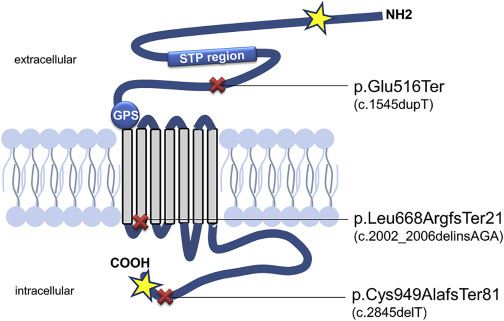Introduction of ADGRG2
ADGRG2, also known as G-protein coupled receptor 64 (GPR64) or Human epididymis-specific protein 6 (HE6), is a protein encoded by the ADGRG2 gene. It is an orphan receptor characterized by a long N-terminus with that has been suggested to be highly glycosylated. Studies have shown that the N-terminus of ADGRG2 is cleaved at the GPS domain to allow for trafficking to the plasma membrane. And the N-terminus after cleavage is believed to remain non-covalently associated with the 7TM.
| Basic Information of ADGRG2 | |
| Protein Name | Adhesion G-protein coupled receptor G2 |
| Gene Name | ADGRG2 |
| Aliases | G-protein coupled receptor 64, Human epididymis-specific protein 6 |
| Organism | Homo sapiens (Human) |
| UniProt ID | Q8IZP9 |
| Transmembrane Times | 7 |
| Length (aa) | 1017 |
| Sequence |
MVFSVRQCGHVGRTEEVLLTFKIFLVIICLHVVLVTSLEEDTDNSSLSPPPAKLSVVSFAPSSNGTPEVE TTSLNDVTLSLLPSNETEKTKITIVKTFNASGVKPQRNICNLSSICNDSAFFRGEIMFQYDKESTVPQNQ HITNGTLTGVLSLSELKRSELNKTLQTLSETYFIMCATAEAQSTLNCTFTIKLNNTMNACAVIAALERVK IRPMEHCCCSVRIPCPSSPEELEKLQCDLQDPIVCLADHPRGPPFSSSQSIPVVPRATVLSQVPKATSFA EPPDYSPVTHNVPSPIGEIQPLSPQPSAPIASSPAIDMPPQSETISSPMPQTHVSGTPPPVKASFSSPTV SAPANVNTTSAPPVQTDIVNTSSISDLENQVLQMEKALSLGSLEPNLAGEMINQVSRLLHSPPDMLAPLA QRLLKVVDDIGLQLNFSNTTISLTSPSLALAVIRVNASSFNTTTFVAQDPANLQVSLETQAPENSIGTIT LPSSLMNNLPAHDMELASRVQFNFFETPALFQDPSLENLSLISYVISSSVANLTVRNLTRNVTVTLKHIN PSQDELTVRCVFWDLGRNGGRGGWSDNGCSVKDRRLNETICTCSHLTSFGVLLDLSRTSVLPAQMMALTF ITYIGCGLSSIFLSVTLVTYIAFEKIRRDYPSKILIQLCAALLLLNLVFLLDSWIALYKMQGLCISVAVF LHYFLLVSFTWMGLEAFHMYLALVKVFNTYIRKYILKFCIVGWGVPAVVVTIILTISPDNYGLGSYGKFP NGSPDDFCWINNNAVFYITVVGYFCVIFLLNVSMFIVVLVQLCRIKKKKQLGAQRKTSIQDLRSIAGLTF LLGITWGFAFFAWGPVNVTFMYLFAIFNTLQGFFIFIFYCVAKENVRKQWRRYLCCGKLRLAENSDWSKT ATNGLKKQTVNQGVSSSSNSLQSSSNSTNSTTLLVNNDCSVHASGNGNASTERNGVSFSVQNGDVCLHDF TGKQHMFNEKEDSCNGKGRMALRRTSKRGSLHFIEQM |
Function of ADGRG2 Membrane Protein
ADGRG2 belongs to the seven transmembrane receptor superfamily, which regulates approximately 80% of signal transduction across the plasma membrane and accounts for 30% of current clinical prescription drug targets.Studies have suggested that it is mainly expressed in human and mouse epididymis as well as human prostate and parathyroid. Importantly, ADGRG2 plays a pivotal role in cancer development and progression. It has been reported that ADGRG2 could promote tumor invasion and metastasis through induction of the placental growth factor (PGF) and metalloproteinase (MMP1) expression. It has been reported that the level of ADGRG2 is significantly upregulated in parathyroid tumors collected from patients with parathyroid hormone. What’s more, ADGRG2 can also use as a novel target gene candidate in ovarian endometrioid adenocarcinoma caused by dysregulation of β-catenin/T-cell factor (TCF) signaling by using oligonucleotide microarrays.
 Fig.1 Schematic Representation of ADGRG2 Structure with the Position of the Amino Acid Changes Resulting from the Identified Truncating Mutations. (Patat, et.al. 2016)
Fig.1 Schematic Representation of ADGRG2 Structure with the Position of the Amino Acid Changes Resulting from the Identified Truncating Mutations. (Patat, et.al. 2016)
Application of ADGRG2 Membrane Protein in Literature
1. Zhang DL., et.al. Gq activity-and β-arrestin-1 scaffolding-mediated ADGRG2/CFTR coupling are required for male fertility. eLife. 2018, 7: e33432. PubMed ID: 29393851
This article reveals that manipulation of the signaling components of the ADGRG2-Gq/β-arrestin-1/CFTR complex by small molecules may be an effective therapeutic strategy for male infertility.
2. Balenga N., et.al. Orphan Adhesion GPCR GPR64/ADGRG2 Is Overexpressed in Parathyroid Tumors and Attenuates Calcium-Sensing Receptor-Mediated Signaling. Journal of Bone and Mineral Research. 2017, 32(3): 654-66. PubMed ID: 27760455
This article suggests that the truncated constitutively active, but not the full-length GPR64 physically interacts with CaSR and attenuates the CaSR-mediated intracellular Ca2+ signaling and cAMP suppression in HEK293 cells. It indicates that GPR64 may be a physiologic regulator of PTH release that is dysregulated in parathyroid tumors, and suggest a role for GPR64 in pathologic calcium-sensing in parathyroid hormone.
3. Patat O., et.al. Truncating mutations in the adhesion G protein-coupled receptor G2 gene ADGRG2 cause an X-linked congenital bilateral absence of vas deferens. The American Journal of Human Genetics. 2016, 99(2): 437-42. PubMed ID: 27476656
This article confirms that ADGRG2 plays a crucial role in human male fertility and brings new insight into congenital obstructive azoospermia pathogenesis.
4. Demberg LM., et.al. Identification of the tethered peptide agonist of the adhesion G protein-coupled receptor GPR64/ADGRG2. Biochemical and biophysical research communications. 2015, 464(3): 743-7. PubMed ID: 26188515
This report suggests that GPR64 can be activated through a tethered agonist sequence, which has previously identified as the Stachel sequence.
5. Yoo JY., et.al. G-protein coupled receptor 64 is required for decidualization of endometrial stromal cells. Scientific reports. 2017, 7(1): 5021. PubMed ID: 28694502
This article reveals that Gpr64 has a crucial role in the decidualization of endometrial stromal cells.
ADGRG2 Preparation Options
In order to provide high-quality membrane protein preparation service, we have developed versatile Magic™ membrane protein production platform. Our experienced scientists will do their best to help you find a perfect match in your required formats. Aided by our versatile Magic™ anti-membrane protein antibody discovery platform, we also provide customized anti-ADGRG2 antibody development services.
Creative Biolabs is dedicated to providing first-class membrane protein production service using a variety of strategies. Based on our leading-edge platform, we have successfully produced, purified, stabilized and characterized many challenging membrane protein targets for global customers. If you are interested in the service we can provide, please feel free to contact us for more information.
Reference
All listed services and products are For Research Use Only. Do Not use in any diagnostic or therapeutic applications.